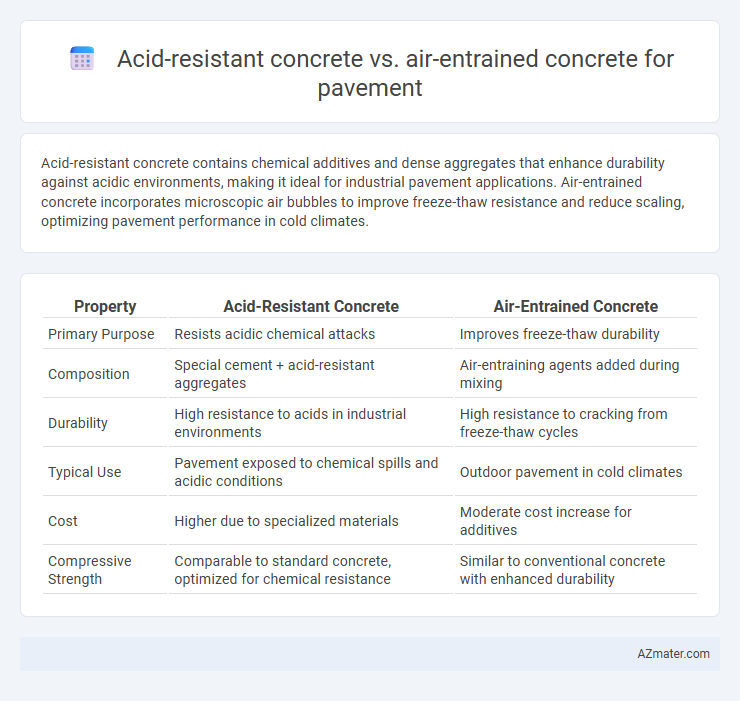Acid-resistant concrete contains chemical additives and dense aggregates that enhance durability against acidic environments, making it ideal for industrial pavement applications. Air-entrained concrete incorporates microscopic air bubbles to improve freeze-thaw resistance and reduce scaling, optimizing pavement performance in cold climates.
Table of Comparison
| Property | Acid-Resistant Concrete | Air-Entrained Concrete |
|---|---|---|
| Primary Purpose | Resists acidic chemical attacks | Improves freeze-thaw durability |
| Composition | Special cement + acid-resistant aggregates | Air-entraining agents added during mixing |
| Durability | High resistance to acids in industrial environments | High resistance to cracking from freeze-thaw cycles |
| Typical Use | Pavement exposed to chemical spills and acidic conditions | Outdoor pavement in cold climates |
| Cost | Higher due to specialized materials | Moderate cost increase for additives |
| Compressive Strength | Comparable to standard concrete, optimized for chemical resistance | Similar to conventional concrete with enhanced durability |
Introduction to Specialized Concrete in Pavement Construction
Acid-resistant concrete is specifically formulated with chemical-resistant aggregates and binders to withstand harsh acidic environments, making it ideal for industrial pavements exposed to corrosive substances. Air-entrained concrete incorporates microscopic air bubbles to enhance durability and resistance to freeze-thaw cycles, improving pavement longevity in colder climates. Both specialized concretes are essential in pavement construction for addressing distinct environmental challenges and ensuring structural integrity.
Understanding Acid-Resistant Concrete: Composition and Benefits
Acid-resistant concrete is formulated with specialized aggregates and chemical admixtures that enhance its durability against acidic environments, making it ideal for pavements exposed to industrial pollutants or acid rain. This concrete type typically incorporates siliceous aggregates, low lime cement, and pozzolanic materials like fly ash or silica fume, which reduce permeability and improve chemical resistance. In contrast to air-entrained concrete, which focuses on freeze-thaw durability through microscopic air bubbles, acid-resistant concrete prioritizes chemical stability and longevity when exposed to aggressive acids.
Air-Entrained Concrete: Definition and Key Properties
Air-entrained concrete incorporates microscopic air bubbles to enhance resistance against freeze-thaw cycles, making it ideal for pavement exposed to cold climates. These air voids improve durability by reducing internal pressure from water expansion during freezing, preventing cracking and scaling. Compared to acid-resistant concrete, which is designed to withstand chemical corrosion, air-entrained concrete primarily focuses on improving mechanical resilience and longevity under harsh environmental conditions.
Environmental Challenges: Acid Exposure vs Freeze-Thaw Cycles
Acid-resistant concrete offers enhanced protection against chemical degradation caused by acidic environments, making it ideal for pavements exposed to industrial pollutants or acid rain. Air-entrained concrete improves durability by incorporating microscopic air bubbles that mitigate freeze-thaw damage, reducing cracking and spalling in cold climates. Selecting between these concretes depends on specific environmental challenges: acid-resistant concrete excels under chemical stress, while air-entrained concrete is optimized for resistance to freezing and thawing cycles.
Durability of Acid-Resistant Concrete in Aggressive Environments
Acid-resistant concrete demonstrates superior durability in aggressive environments due to its specialized composition that withstands chemical corrosion from acidic substances commonly found in industrial and wastewater pavements. This type of concrete incorporates acid-resistant aggregates and coatings that prevent deterioration, significantly extending pavement lifespan compared to standard air-entrained concrete, which primarily enhances freeze-thaw resistance rather than chemical resilience. Consequently, acid-resistant concrete is the preferred choice for pavements exposed to acidic conditions, offering enhanced structural integrity and reduced maintenance costs in harsh environments.
Performance of Air-Entrained Concrete Under Climate Extremes
Air-entrained concrete enhances pavement durability by introducing microscopic air bubbles that improve freeze-thaw resistance in climate extremes, reducing surface scaling and cracking. In contrast, acid-resistant concrete is formulated with special cementitious materials and additives to withstand chemical attack but may not offer significant freeze-thaw protection. The performance of air-entrained concrete under severe cold and wet conditions makes it the preferred choice for pavements in regions experiencing frequent temperature fluctuations and deicing salt exposure.
Comparative Analysis: Lifespan and Maintenance Needs
Acid-resistant concrete exhibits superior durability in chemically aggressive environments, significantly extending pavement lifespan by resisting sulfate and acid attacks that degrade standard materials; air-entrained concrete, designed to improve freeze-thaw resistance, offers enhanced durability in climates with frequent temperature fluctuations but less protection against chemical corrosion. Maintenance needs for acid-resistant concrete are generally lower in industrial or high-pollution areas due to its chemical resilience, whereas air-entrained concrete requires regular inspection and potential repair to address freeze-thaw damage in colder regions. Selecting between the two depends on environmental exposure: acid-resistant concrete is optimal for industrial pavements facing chemical exposure, while air-entrained concrete suits cold climates where mechanical freeze-thaw stress predominates.
Cost Considerations in Selecting Pavement Concrete Types
Acid-resistant concrete typically incurs higher initial costs due to specialized materials like silica fume and chemical-resistant admixtures, which enhance durability against acidic environments, making it suitable for industrial pavements exposed to corrosive substances. Air-entrained concrete generally costs less upfront and is widely used for freeze-thaw protection in climates with frequent temperature fluctuations, providing improved longevity and reduced maintenance expenses in such conditions. Evaluating the total lifecycle cost, including material expense, maintenance frequency, and environmental exposure, is crucial for cost-effective pavement concrete selection.
Best Applications: When to Choose Acid-Resistant or Air-Entrained Concrete
Acid-resistant concrete excels in environments exposed to acidic chemicals, such as industrial floors and wastewater treatment plants, due to its enhanced durability against chemical corrosion. Air-entrained concrete is ideal for pavements in cold climates where freeze-thaw cycles occur, as its microscopic air bubbles increase resistance to cracking and scaling. Choosing between acid-resistant and air-entrained concrete depends on exposure conditions--select acid-resistant for chemical attack and air-entrained for freeze-thaw durability.
Conclusion: Making the Right Choice for Pavement Projects
Acid-resistant concrete offers superior protection against chemical attack, making it ideal for pavements exposed to industrial environments or acidic substances, while air-entrained concrete enhances durability by improving freeze-thaw resistance in colder climates. Selecting the right concrete depends on site-specific factors such as exposure to chemicals, climate conditions, and intended pavement lifespan. Prioritizing these considerations ensures optimized performance, longevity, and cost-effectiveness in pavement projects.

Infographic: Acid-resistant concrete vs Air-entrained concrete for Pavement
 azmater.com
azmater.com